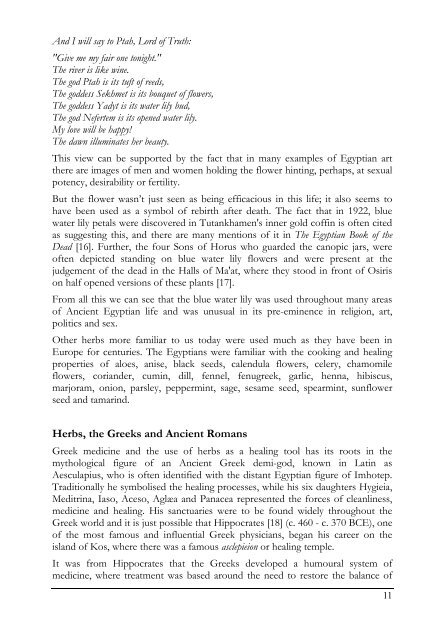A Magickal Herball Compleat.pdf - Magicka School
A Magickal Herball Compleat.pdf - Magicka School
A Magickal Herball Compleat.pdf - Magicka School
You also want an ePaper? Increase the reach of your titles
YUMPU automatically turns print PDFs into web optimized ePapers that Google loves.
And I will say to Ptah, Lord of Truth:<br />
"Give me my fair one tonight."<br />
The river is like wine.<br />
The god Ptah is its tuft of reeds,<br />
The goddess Sekhmet is its bouquet of flowers,<br />
The goddess Yadyt is its water lily bud,<br />
The god Nefertem is its opened water lily.<br />
My love will be happy!<br />
The dawn illuminates her beauty.<br />
This view can be supported by the fact that in many examples of Egyptian art<br />
there are images of men and women holding the flower hinting, perhaps, at sexual<br />
potency, desirability or fertility.<br />
But the flower wasn’t just seen as being efficacious in this life; it also seems to<br />
have been used as a symbol of rebirth after death. The fact that in 1922, blue<br />
water lily petals were discovered in Tutankhamen's inner gold coffin is often cited<br />
as suggesting this, and there are many mentions of it in The Egyptian Book of the<br />
Dead [16]. Further, the four Sons of Horus who guarded the canopic jars, were<br />
often depicted standing on blue water lily flowers and were present at the<br />
judgement of the dead in the Halls of Ma'at, where they stood in front of Osiris<br />
on half opened versions of these plants [17].<br />
From all this we can see that the blue water lily was used throughout many areas<br />
of Ancient Egyptian life and was unusual in its pre-eminence in religion, art,<br />
politics and sex.<br />
Other herbs more familiar to us today were used much as they have been in<br />
Europe for centuries. The Egyptians were familiar with the cooking and healing<br />
properties of aloes, anise, black seeds, calendula flowers, celery, chamomile<br />
flowers, coriander, cumin, dill, fennel, fenugreek, garlic, henna, hibiscus,<br />
marjoram, onion, parsley, peppermint, sage, sesame seed, spearmint, sunflower<br />
seed and tamarind.<br />
Herbs, the Greeks and Ancient Romans<br />
Greek medicine and the use of herbs as a healing tool has its roots in the<br />
mythological figure of an Ancient Greek demi-god, known in Latin as<br />
Aesculapius, who is often identified with the distant Egyptian figure of Imhotep.<br />
Traditionally he symbolised the healing processes, while his six daughters Hygieia,<br />
Meditrina, Iaso, Aceso, Aglæa and Panacea represented the forces of cleanliness,<br />
medicine and healing. His sanctuaries were to be found widely throughout the<br />
Greek world and it is just possible that Hippocrates [18] (c. 460 - c. 370 BCE), one<br />
of the most famous and influential Greek physicians, began his career on the<br />
island of Kos, where there was a famous asclepieion or healing temple.<br />
It was from Hippocrates that the Greeks developed a humoural system of<br />
medicine, where treatment was based around the need to restore the balance of<br />
11




